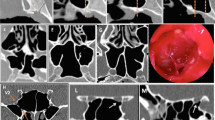Abstract
Object
The transsphenoidal approach is guided by a few fundamental anatomic landmarks. Pneumatization of the SS is variable, and this plays a key role in accessing the sella floor and other skull base structures. It may be absent or minimally present in both adult and, often, pediatric population, making surgical approach more difficult than usual. We aim to demonstrate that also in the more difficult cases, with a minimal level of pneumatization, the transsphenoidal approach is still possible especially with the support of neuronavigation and intraoperative magnetic resonance imaging (iMRI).
Methods
We present our experience accumulated after the treatment of 6 children with minimally pneumatized sphenoid sinus describing the workflow to access the sella floor.
Results
No perioperative complications due to the surgical approach were observed, and no cases of mortality were reported. After the surgery, the visual field deficit improved in 1 patient and remained stable in three patients. No postoperative new neurologic deficits were found. No cases of cerebrospinal fluid (CSF) leak were observed.
Conclusions
The transsphenoidal approach can be safely used even in cases of minimally or even absent pneumatization of SS as in young children. In order to have a safe approach in such patients, the use of tools, such as navigation system and iMRI, is recommended. Furthermore, the iMRI allows to avoid exposure to radiation as in case of fluoroscopy.





Similar content being viewed by others
References
Berker M, Hazer DB, Yucel T, Gurlek A, Cila A, Aldur M, Onerci M (2012) Complications of endoscopic surgery of the pituitary adenomas: analysis of 570 patients and review of the literature. Pituitary 15:288–300. https://doi.org/10.1007/s11102-011-0368-2
Carrabba G, Locatelli M, Mattei L, Guastella C, Mantovani G, Rampini P, Gaini SM (2013) Transphenoidal surgery in acromegalic patients: anatomical considerations and potential pitfalls. Acta Neurochir 155:125–130; discussion 130. https://doi.org/10.1007/s00701-012-1527-6
Dixon FW (1958) The clinical significance of the anatomical arrangement of the paranasal sinuses. Ann Otol Rhinol Laryngol 67:736–741. https://doi.org/10.1177/000348945806700311
Dusick JR, Esposito F, Malkasian D, Kelly DF (2007) Avoidance of carotid artery injuries in transsphenoidal surgery with the Doppler probe and micro-hook blades. Neurosurgery 60:322–328; discussion 328–329. https://doi.org/10.1227/01.neu.0000255408.84269.a8
Furtado SV, Thakar S, Hegde AS (2012) The use of image guidance in avoiding vascular injury during trans-sphenoidal access and decompression of recurrent pituitary adenomas. J Craniofac Genet Dev Biol 40:680–684. https://doi.org/10.1016/j.jcms.2011.12.002
Giordano M, Samii A, Lawson McLean AC, Bertalanffy H, Fahlbusch R, Samii M, Di Rocco C (2017) Intraoperative magnetic resonance imaging in pediatric neurosurgery: safety and utility. J Neurosurg Pediatr 19:77–84. https://doi.org/10.3171/2016.8.PEDS15708
Hamid O, El Fiky L, Hassan O, Kotb A, El Fiky S (2008) Anatomic variations of the sphenoid sinus and their impact on trans-sphenoid pituitary surgery. Skull Base 18:9–15. https://doi.org/10.1055/s-2007-992764
Hammar G (1960) The sphenoidal sinus in its relation to the sella turcica. Trans Ann Meet Am Laryngol Assoc Am Laryngol Assoc Ann Meet 81:182–184
Hammer G, Radberg C (1961) The sphenoidal sinus. An anatomical and roentgenologic study with reference to transsphenoid hypophysectomy. Acta Radiol 56:401–422
Hardy J, Wigser SM (1965) Trans-sphenoidal surgery of pituitary fossa tumors with televised radiofluoroscopic control. J Neurosurg 23:612–619. https://doi.org/10.3171/jns.1965.23.6.0612
Hinck VC, Hopkins CE (1965) Concerning growth of the sphenoid sinus. Arch Otolaryngol (Chicago, Ill: 1960) 82:62–66. https://doi.org/10.1001/archotol.1965.00760010064015
Jovanovic S, Lotric N, Radojevic V (1954) Development, morphology and topography of sphenoidal sinuses in children. Acta Med Iugoslavica 8:232–252
Massoud AF, Powell M, Williams RA, Hindmarsh PC, Brook CG (1997) Transsphenoidal surgery for pituitary tumours. Arch Dis Child 76:398–404. https://doi.org/10.1136/adc.76.5.398
Nomikos P, Fahlbusch R, Buchfelder M (2004) Recent developments in transsphenoidal surgery of pituitary tumors. Hormones (Athens, Greece) 3:85–91
Rhoton AL Jr (2002) The sellar region. Neurosurgery 51:S335–S374
Song Y, Wang T, Chen J, Tan G (2015) Endoscopic transsphenoidal resection of sellar tumors with conchal sphenoid sinus: a report of two cases. Oncol Lett 9:713–716. https://doi.org/10.3892/ol.2014.2732
Author information
Authors and Affiliations
Corresponding author
Ethics declarations
Conflict of interest
On behalf of all the authors, the corresponding author states that there is no conflict of interest.
Additional information
Publisher’s note
Springer Nature remains neutral with regard to jurisdictional claims in published maps and institutional affiliations.
Rights and permissions
About this article
Cite this article
Gallieni, M., Zaed, I., Fahlbusch, R. et al. Transsphenoidal approach in children with partially or minimally developed sphenoid sinus. Childs Nerv Syst 37, 131–136 (2021). https://doi.org/10.1007/s00381-020-04757-6
Received:
Accepted:
Published:
Issue Date:
DOI: https://doi.org/10.1007/s00381-020-04757-6




